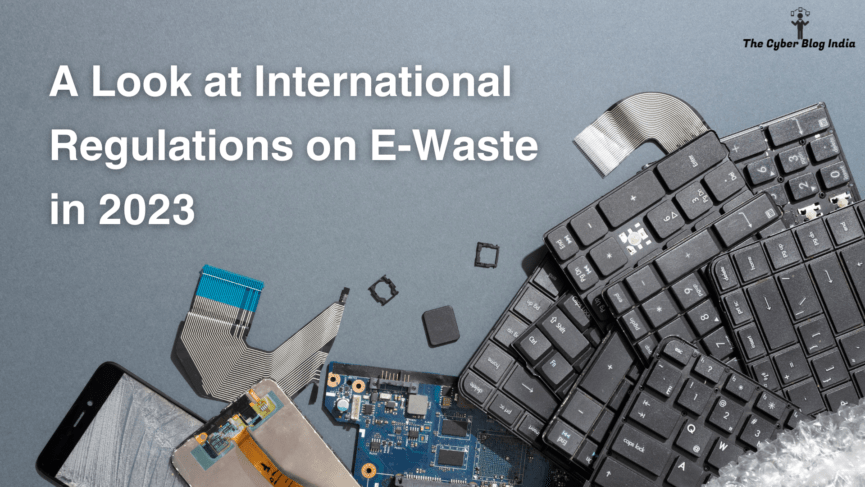A Look at International Regulations on E-Waste in 2023

We produced a compelling 2.4 kg per capita e-waste in India in 2019. However, the problem of e-waste runs deeper than just in India. By 2050, global e-waste production is set to reach a worrying 120 million tonnes per year. This is more than twice what the number is at present! Electronic waste, or e-waste, refers to discarded electrical and electronic equipment. Televisions, computers, lamps, mobile phones, refrigerators, etcetera are all examples of it. E-waste has become one of the fastest-growing waste streams in today’s time. This article looks at international regulations and country-specific legal initiatives for e-waste regulation.
The Basel Convention
The Basel Convention on the Control of Transboundary Movements of Hazardous Wastes and Their Disposal is an international treaty effective May 1992. This treaty prohibits the transfer of e-waste from developed to developing countries. Over 180 countries came together at the Basel Convention in Switzerland to sign the treaty, enforcing legalisations that reduced the world’s transboundary movement of hazardous waste. However, the issue of e-waste is yet to be quashed entirely. Estimates suggest that the European Union (EU), for instance, illegally exports 352,474 metric tonnes of e-waste to developing countries yearly. The United States has gone so far as to not ratify the treaty despite being one of the highest e-waste-producing countries in the world.
Europe
Europe—the EU, in particular— has been at the forefront of introducing regulations on e-waste over the years. The EU introduced the Waste Shipment Regulation (WSR) in 1993, which prohibited the shipment of hazardous e-waste from its member states to non-OECD countries. It then launched the Restriction of Hazardous Substances (RoHS) Directive, which limited the use of hazardous substances in the manufacturing and packaging of electrical equipment and also sought to increase the recycling of e-waste.
In 2012 came the new Waste from Electrical and Electronic Equipment (WEEE) Directive (2012/19/EU), which listed the requirements for proper disposal of e-waste to ensure high recycling and subsequent high reusability of the waste. Also, the producers of said equipment have the responsibility of responsible disposal and recycling imposed on them. The WEEE regulations are applicable in member states of the EU, the UK and Norway. Countries like Switzerland, Iceland, and others have similar national legislation.
Oceania
In Oceania, Australia has enacted a national law on e-waste regulation. Under the Product Stewardship Act 2011, regulations provide the service of recycling televisions and computers to households and small businesses. New Zealand and other countries in the Pacific Islands region, in contrast, are yet to develop a national law specifically for the same. The latter depends mainly on the Secretariat of the Pacific Regional Environment Programme (SPREP) and the EU to coordinate and promote waste management in the region.
Asia
In 2011, the Indian government introduced the E-Waste Management and Handling Rules, which introduced Extended Producer Responsibility (EPR). The producers of EEE were made responsible for e-waste management. Since then, it has updated the e-waste rules in 2016 (to introduce provisions on authorisation, product stewardship and Producer Responsibility Organisations) and in 2022 (to prohibit the use of hazardous materials in the manufacture of goods and establish a target for producers for recycling of up to 70% of all e-waste in the coming years). A detailed discussion on e-waste regulation in India is available here.
China’s national e-waste legislation regulates the collection and management of 14 types of e-waste. These include televisions, refrigerators, washing machines, air conditioners, personal computers, range hoods, electric water heaters, gas water heaters, fax machines, mobile phones, single-machine telephones, printers, copiers, and monitors. China’s first ban on e-waste imports came after the Basel Ban, before which the country received WEEE from developed nations. Since then, the country’s government has introduced several regulations which seek to standardise e-waste recycling in national and provincial systems.
Some countries in Southeast Asia, like the Philippines, Cambodia, and Myanmar, are advancing regulations on the management of hazardous waste to promote proper WEEE management. In contrast, most countries in Central and Western Asia are lagging in this regard. Even if a country has WEEE legislation (like Kazakhstan’s EPR system), they lack the infrastructure to manage the e-waste fully. Or in the case of the United Arab Emirates (UAE), which has a specialised facility for e-waste in Dubai, the problem of e-waste management remains primarily in the informal sector.
Africa
African nations have received a significant portion of the illegal e-waste exported out of developed nations over the years despite the continent not having sufficient e-waste management systems in place. The informal sector dominates the management of e-waste in Africa — scrapyards like Agbogbloshie (Africa’s biggest e-waste dump) in Ghana have workers who search for valuable metals like aluminium and copper in the e-waste. Even in countries with national or regional legislation (Egypt, Ghana, Madagascar, Nigeria, Rwanda, South Africa, etc.), enforcing the regulations is challenging. Still, it is crucial to note that governments in the continent are taking steps to change the scenario.
Conclusion
Climate change and technology are the two realities of this century. When combined for the worse, they make the world’s plight more wretched than ever before. July 2023 signalled a move from global warming to “global boiling“, according to the UN. A similar predicament awaits climate change, and this stream of e-waste might just be the catalyst that pushes climate change to climate catastrophe. Let’s be more considerate and ensure e-waste is treated adequately globally.
Featured Image Credits: Image by Freepik
